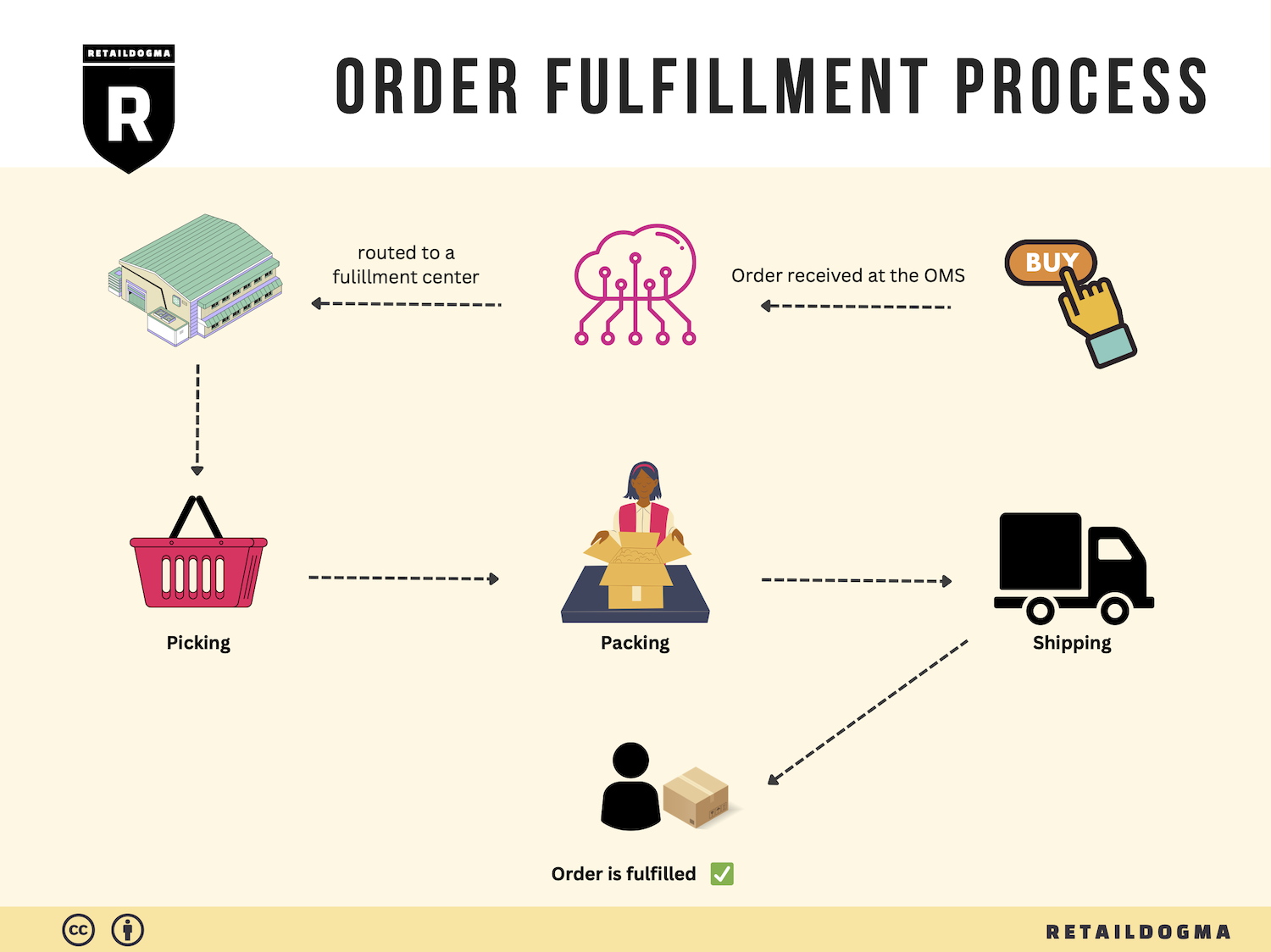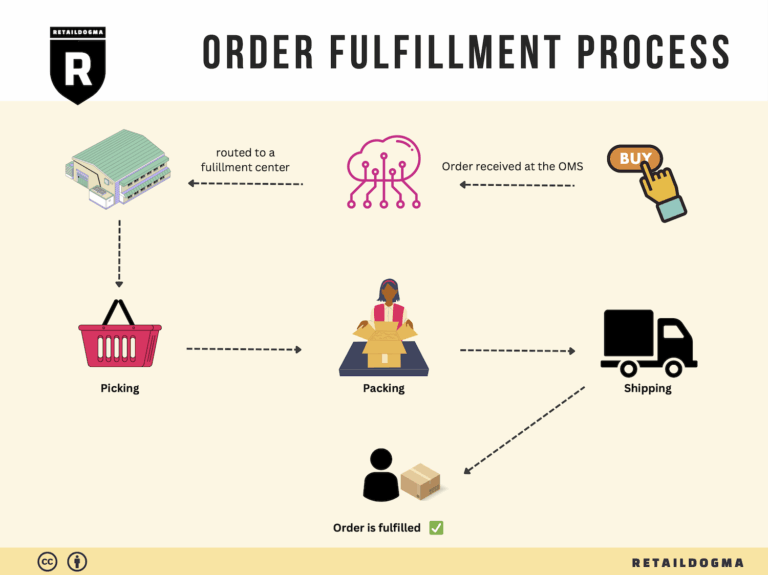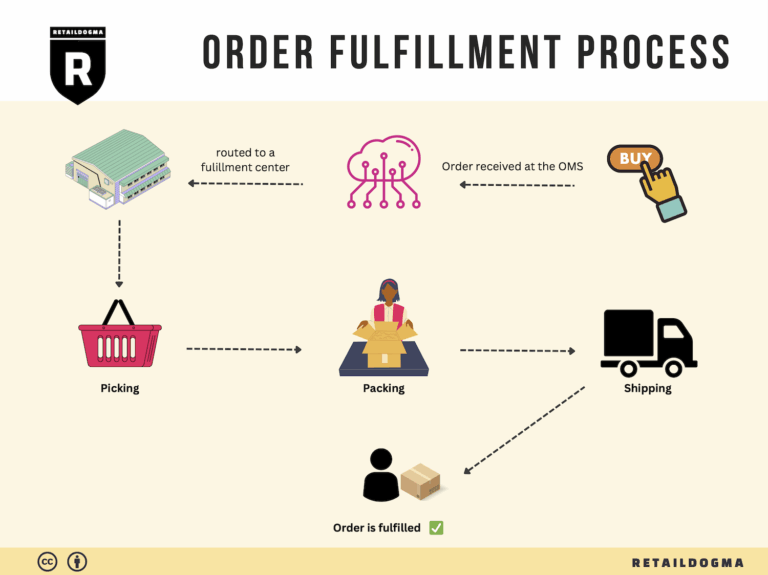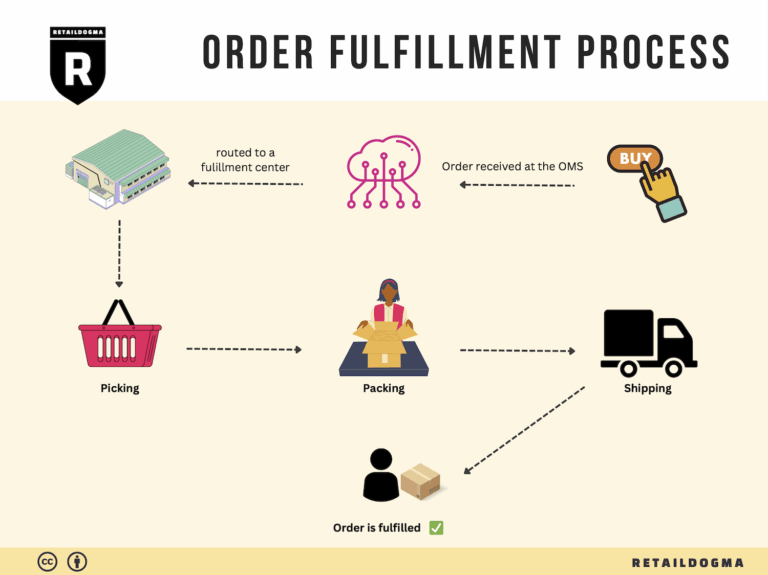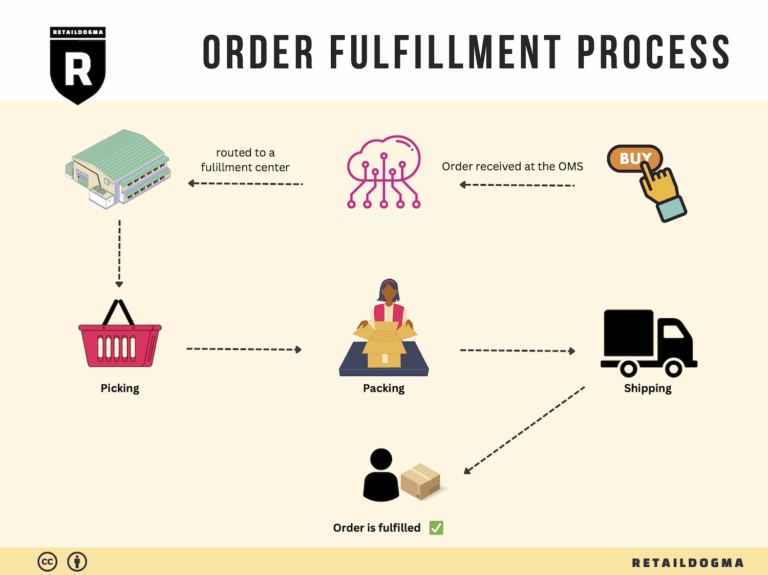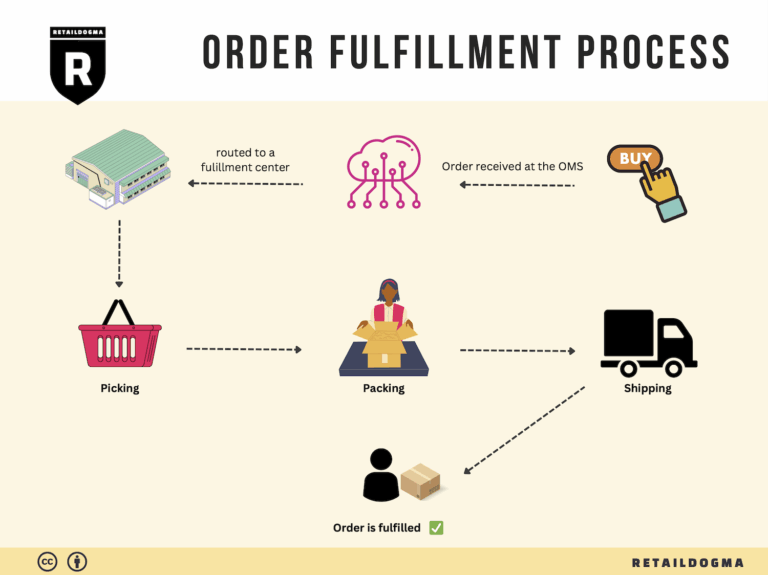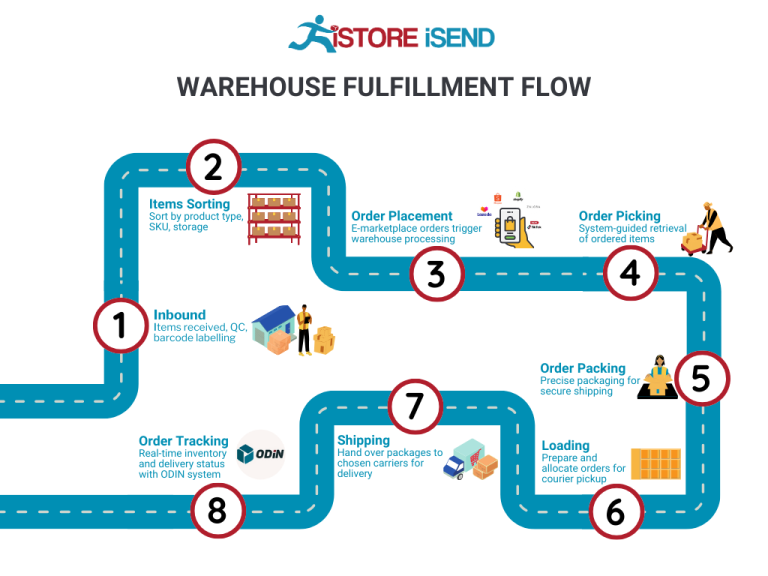Ecommerce Fulfillment Services: The Ultimate Guide (2025)
What is E-commerce Fulfillment? An Introduction for Growing Businesses
Navigating the Challenges of E-commerce Fulfillment
As an e-commerce business owner, you may find yourself overwhelmed by the sheer volume of orders you need to pack and ship. The excitement of growing sales can quickly turn into stress when you realize that managing logistics is taking time away from your core business activities. This is a common pain point for many growing online retailers. After all, fulfillment—the process of getting a product to a customer—can be complex, involving multiple steps from inventory management to shipping logistics.
In this guide, we will demystify e-commerce fulfillment and provide practical insights to help you scale your operations effectively. We will explore various fulfillment models, including Third-Party Logistics (3PL) and Fulfillment by Amazon (FBA), each offering unique advantages depending on your business needs. Understanding these options will enable you to choose the best path for your brand.
We will also delve into the core services that fulfillment partners typically provide. This includes warehousing, order processing, inventory management, shipping, and returns handling. Knowing what to expect from a fulfillment partner can help you assess potential providers and their alignment with your business goals.
Choosing the right fulfillment partner is critical for your success. This guide will cover key criteria to consider when evaluating potential partners, such as their technology capabilities, service level agreements (SLAs), and customer support. We will also discuss how to negotiate pricing and what factors influence costs, helping you make informed decisions that can impact your bottom line.
Ultimately, our goal is to empower you to make smart logistics decisions that support your e-commerce growth. By understanding the intricacies of fulfillment and leveraging expert insights, you can focus on what matters most: delivering exceptional products and experiences to your customers. Whether you’re considering outsourcing your fulfillment or optimizing your existing processes, this guide aims to equip you with the knowledge you need to thrive in the competitive e-commerce landscape.
What You’ll Learn In This Guide
- What is E-commerce Fulfillment? An Introduction for Growing Businesses
- The Order Fulfillment Process: From ‘Buy’ Button to Customer’s Door
- Comparing Fulfillment Models: In-House vs. 3PL vs. Dropshipping
- A Deep Dive into Amazon FBA: Pros, Cons, and Who It’s For
- Core Services Offered by Fulfillment Centers
- How to Choose a Fulfillment Partner: A 6-Point Checklist
- Understanding Fulfillment Pricing: A Breakdown of Common Fees
- Frequently Asked Questions (FAQs) about Fulfillment
- Conclusion: Is Outsourcing Fulfillment the Right Move for Your Business?
- Important Disclaimer
The Order Fulfillment Process: From ‘Buy’ Button to Customer’s Door
1. Receiving Inventory
The order fulfillment process begins with the receiving of inventory, where products are delivered to the warehouse. This step is critical as it sets the foundation for accurate inventory management and ensures that the right products are available for order fulfillment. When products arrive, they are inspected for quality and quantity against purchase orders to ensure everything matches.
A key term associated with this step is SKU (Stock Keeping Unit). Each product should have a unique SKU that allows for easy tracking and management within the warehouse system. This precision is vital because discrepancies during this stage can lead to stockouts or overstock situations, adversely affecting customer satisfaction and operational efficiency.
2. Warehouse Storage
Once inventory is received and verified, it is then organized and stored in the warehouse. Effective warehouse storage is essential for optimizing space and ensuring that products can be easily accessed when needed. Products are often categorized and stored based on various factors such as size, weight, and demand frequency.
A key term in this phase is FIFO (First In, First Out). This inventory management strategy ensures that older stock is sold before newer stock, reducing the risk of obsolescence and spoilage, especially for perishable goods. Proper warehouse storage not only enhances efficiency in picking and packing but also contributes to overall inventory accuracy and reduces operational costs.
3. Order Picking
When a customer places an order, the next step is order picking, where items are selected from storage to fulfill the order. This process can be performed using different methods, including single order picking or batch picking, depending on the volume of orders and efficiency needs.
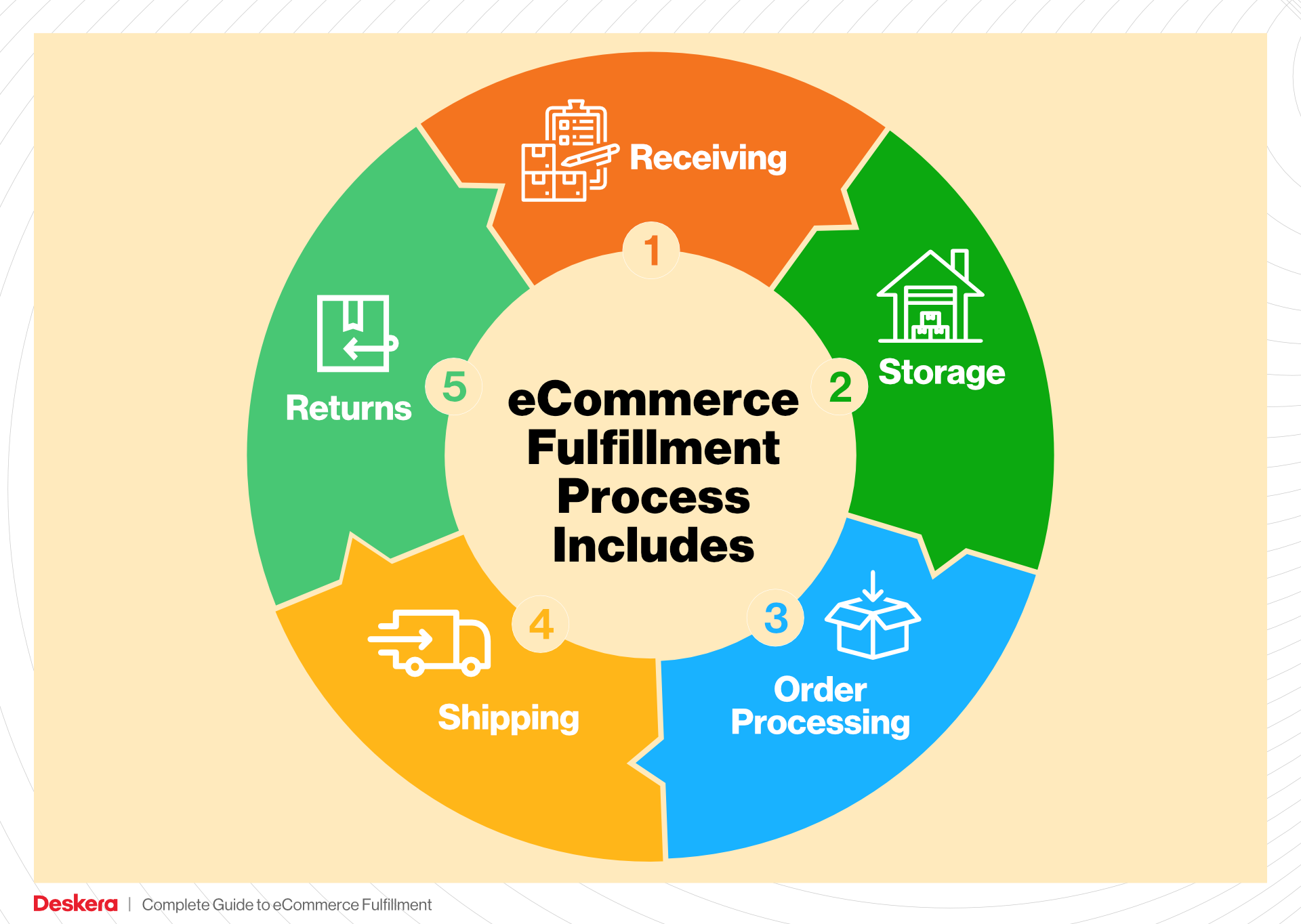
A crucial element of this step is the use of pick lists. These lists detail the specific items and quantities needed for each order, guiding warehouse staff through the picking process. Efficient order picking is vital because delays or errors at this stage can lead to incorrect shipments, increased return rates, and ultimately a negative customer experience. By streamlining the picking process, businesses can enhance speed and accuracy, which are both critical for customer satisfaction.
4. Order Packing
After items are picked, they move to the order packing stage, where products are carefully packaged for shipping. This step is crucial as it protects the items during transit and ensures they arrive at the customer’s door in excellent condition. Proper packing also involves selecting the right materials and methods to minimize shipping costs while maximizing protection.
In this context, packaging materials play a key role. From boxes to cushioning materials, the right packaging can prevent damage and enhance the unboxing experience for customers. Additionally, including packing slips and return labels can facilitate smooth returns, contributing to a positive overall customer experience. Effective packing not only safeguards products but also reflects the brand’s commitment to quality and service.
5. Shipping & Delivery
The final step in the order fulfillment process is shipping and delivery, where packed orders are dispatched to customers. This stage is paramount as it represents the culmination of the fulfillment process and directly impacts customer satisfaction. Timely and accurate shipping can enhance customer loyalty and encourage repeat business.
A significant term in this phase is last-mile delivery. This refers to the final step of the delivery process, where the product is transported from a transportation hub to the customer’s door. Efficient last-mile delivery is essential as it often constitutes the most significant portion of shipping costs and can be a major determinant of customer satisfaction. By optimizing shipping routes and utilizing technology for tracking and updates, businesses can ensure that customers receive their orders promptly and reliably.
In conclusion, understanding and mastering each step of the order fulfillment process is essential for e-commerce businesses aiming to scale efficiently. By focusing on accuracy, speed, and customer experience throughout the process—from receiving inventory to shipping and delivery—businesses can create a seamless fulfillment operation that drives growth and enhances customer loyalty.
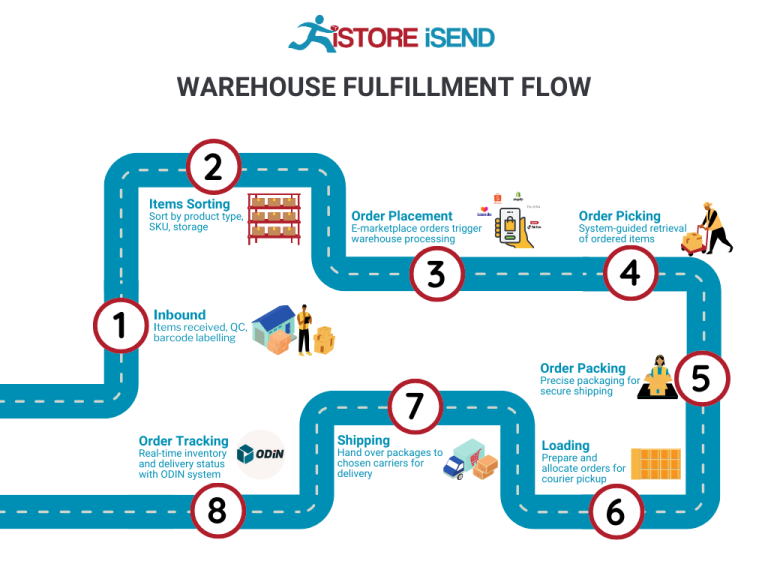
Comparing Fulfillment Models: In-House vs. 3PL vs. Dropshipping
Fulfillment Model Comparison Table
| Model | Who Handles Inventory | Best For (Business Stage) | Key Advantage | Key Disadvantage |
|---|---|---|---|---|
| In-House Fulfillment | The business itself | Established businesses | Full control over operations | High overhead costs |
| Third-Party Logistics (3PL) | A third-party provider | Startups and scaling businesses | Scalability and expertise | Less control over the fulfillment process |
| Dropshipping | Supplier/vendor | New businesses or niche markets | Low startup costs | Lower margins and longer shipping times |
In-House Fulfillment
In-house fulfillment involves managing the entire logistics process within the business itself. This model is typically suited for established businesses that have the resources to invest in warehouse space, staffing, and technology. Companies that opt for in-house fulfillment enjoy full control over their operations, which allows for tailored processes and immediate responses to customer needs. This can lead to a better customer experience since businesses can ensure that orders are processed, packed, and shipped according to their specific standards. However, the key disadvantage of in-house fulfillment is the significant overhead costs involved, including warehousing expenses, labor, and the need for a robust inventory management system. As the business scales, maintaining efficiency and managing costs can become increasingly challenging.
Third-Party Logistics (3PL)
Third-party logistics (3PL) refers to outsourcing the logistics operations to a specialized provider. This model is ideal for startups and businesses looking to scale quickly without the burden of managing logistics in-house. 3PL providers, like iDrive Logistics, bring expertise and established networks to the table, allowing businesses to focus on core activities such as marketing and product development. A key advantage of using a 3PL is the ability to scale operations rapidly, as these providers often have multiple warehouses and logistics solutions that can accommodate fluctuating demand. Moreover, they typically offer advanced technology for inventory management and order fulfillment, which can enhance overall efficiency. However, businesses may face challenges related to less control over the fulfillment process. This can result in variability in service levels and customer experience, particularly if the chosen 3PL does not align closely with the brand’s standards.
Dropshipping
Dropshipping is a fulfillment method where the retailer does not keep goods in stock but instead transfers customer orders directly to a supplier, who then ships the products to the customer. This model is particularly well-suited for new businesses or those operating in niche markets with limited capital. One of the main advantages of dropshipping is its low startup costs; entrepreneurs can launch e-commerce stores without the need for substantial inventory investments or warehouse space. Additionally, dropshipping allows businesses to offer a wide range of products without the risk of unsold stock. However, the primary downside is the lower profit margins due to reliance on suppliers, which can limit growth potential. Furthermore, shipping times can be longer, leading to potential customer dissatisfaction if suppliers are not efficient. This model also requires careful selection of reliable suppliers to maintain product quality and service levels.
In summary, each fulfillment model presents unique advantages and challenges. Choosing the right model depends on the specific needs, resources, and growth stage of the business. E-commerce operators must weigh factors such as control, cost, scalability, and customer experience to determine the most effective fulfillment strategy for their operations.
A Deep Dive into Amazon FBA: Pros, Cons, and Who It’s For
Understanding Fulfillment by Amazon (FBA)
Fulfillment by Amazon (FBA) is a service provided by Amazon that allows sellers to store their products in Amazon’s fulfillment centers. Amazon then takes care of the storage, packaging, and shipping of these products, as well as customer service and returns. This service is particularly attractive to e-commerce businesses seeking to streamline their operations and leverage Amazon’s vast logistics network.
How FBA Works
-
Setting Up: Sellers create an Amazon seller account and enroll in FBA. They can then list their products on Amazon and prepare them for shipment to Amazon’s fulfillment centers.
-
Shipping to Amazon: After preparing their inventory, sellers ship their products to Amazon’s warehouses. Sellers can choose to ship directly to one fulfillment center or multiple centers based on Amazon’s recommendations.
-
Storage and Management: Once the products are received, Amazon stores them in its fulfillment centers. Sellers can track their inventory levels through the seller dashboard.
-
Order Fulfillment: When a customer places an order, Amazon picks, packs, and ships the product on behalf of the seller. The seller does not need to handle the logistics, which can save significant time and effort.
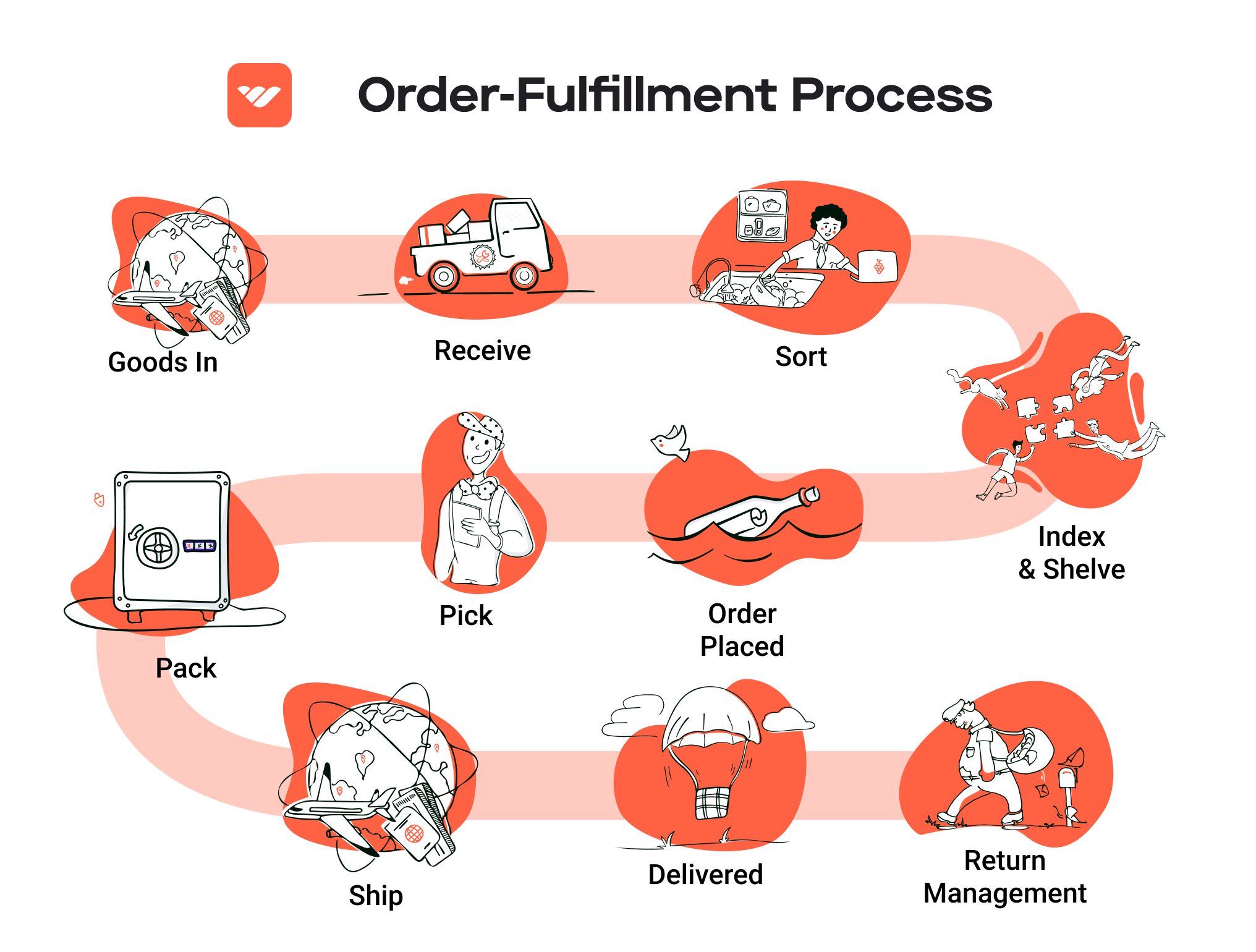
-
Customer Service and Returns: Amazon also manages customer service inquiries and handles returns for products sold through FBA, ensuring a seamless experience for customers.
Pros of Using FBA
-
Prime Eligibility: Products fulfilled by Amazon are automatically eligible for Amazon Prime, which can significantly increase sales due to the large number of Prime members who prefer fast, free shipping.
-
Enhanced Customer Trust: Amazon’s reputable brand lends credibility to sellers. Customers are more likely to purchase from sellers using FBA due to the trusted fulfillment process and reliable customer service.
-
Multi-Channel Fulfillment: FBA allows sellers to fulfill orders from other sales channels, such as their own websites or other marketplaces. This flexibility can help businesses maintain consistent inventory levels and streamline logistics.
-
Scalability: FBA allows businesses to scale quickly without the need for additional warehousing or logistics staff. As orders increase, Amazon’s infrastructure can handle the additional volume with ease.
-
Time Savings: By outsourcing logistics to Amazon, sellers can focus on other aspects of their business, such as marketing and product development, rather than worrying about storage, packing, and shipping.
-
Access to Advanced Tools: Sellers using FBA have access to Amazon’s analytics tools, which can provide insights into sales trends, inventory management, and customer behavior.
Cons of Using FBA
-
High Fees: FBA charges various fees, including storage fees for inventory and fulfillment fees for each order shipped. For some sellers, these costs can eat into profit margins, particularly for low-priced items.
-
Strict Inventory Rules: Amazon has stringent policies regarding inventory management, including how products must be prepared and labeled. Non-compliance can lead to additional fees or penalties.
-
Commingling Risks: FBA often commingles inventory from multiple sellers, meaning that products from different sellers can be stored together. This can pose risks if a seller’s product is damaged or if customers receive the wrong item.
-
Limited Control Over Fulfillment: Sellers have less control over the fulfillment process compared to handling logistics independently. This can lead to challenges if issues arise with order fulfillment, packaging, or shipping times.
-
Inventory Limitations: Amazon may impose inventory limits based on a seller’s sales history or performance metrics. This can restrict the ability to scale up operations quickly.
-
Complex Returns Process: While Amazon handles returns, the process can be complicated for sellers, especially if they want to manage returned inventory differently than Amazon’s standard procedures.
Who is FBA Best For?
Fulfillment by Amazon is ideal for various types of sellers, particularly:
-
Small to Medium-Sized E-commerce Businesses: Businesses that lack the infrastructure to manage their own logistics can benefit significantly from FBA’s comprehensive services.
-
Brands Looking to Scale: Sellers aiming for rapid growth can leverage Amazon’s established logistics network and customer base to expand their reach without a hefty investment in warehousing and fulfillment.
-
Retailers with Seasonal Products: FBA can help retailers manage fluctuating demand during peak seasons without the overhead of maintaining a large warehouse year-round.
-
Entrepreneurs Focused on Marketing: Sellers who want to prioritize marketing and product development rather than fulfillment will find FBA a valuable asset in streamlining operations.
-
Multi-Channel Sellers: Businesses that sell across multiple platforms can benefit from FBA’s multi-channel fulfillment capabilities, ensuring consistent inventory and customer experience.
In conclusion, Fulfillment by Amazon offers substantial advantages for many e-commerce businesses, particularly those looking to harness Amazon’s logistics capabilities to grow their operations. However, potential users should carefully weigh the pros and cons to determine if FBA aligns with their business goals and operational needs.
Core Services Offered by Fulfillment Centers
Inventory Management & Warehousing
Inventory management and warehousing are foundational services provided by fulfillment centers that enable e-commerce businesses to maintain control over their stock levels and ensure the efficient storage of goods. This service involves not just the physical storage of products but also systematic processes for tracking inventory levels, managing stock rotation, and implementing controls such as FIFO (First In, First Out) to minimize waste.
For e-commerce businesses, effective inventory management is crucial. It helps prevent stockouts, which can lead to lost sales and dissatisfied customers, as well as overstock situations that tie up capital in unsold goods. By partnering with a fulfillment center, businesses gain access to advanced inventory tracking systems that provide real-time visibility into stock levels. This transparency allows for better forecasting and demand planning, ultimately leading to more informed purchasing decisions and improved cash flow.
Additionally, modern warehousing facilities are often equipped with advanced technology, such as barcode scanning and RFID systems, that streamline inventory processes. These capabilities not only enhance accuracy but also reduce the time spent on manual inventory checks, enabling businesses to focus on scaling operations and improving customer service.
Pick and Pack Services
Pick and pack services are integral to the fulfillment process, involving the selection (or “picking”) of products from inventory and preparing them for shipment (or “packing”). Fulfillment centers employ dedicated staff and efficient systems to ensure that orders are fulfilled quickly and accurately, which is vital for maintaining customer satisfaction.
The benefit of utilizing pick and pack services lies in speed and efficiency. When an order is placed, fulfillment center staff can quickly locate the required items in the warehouse, assemble them, and prepare them for shipping. This rapid order processing is essential for e-commerce businesses aiming to meet customer expectations for fast delivery. In fact, many consumers now expect same-day or next-day shipping, making efficient pick and pack operations a competitive necessity.
Moreover, fulfillment centers often utilize automated solutions, such as conveyor systems and packing stations, to further enhance efficiency and reduce errors in the picking process. With high accuracy rates—often exceeding 99.9%—businesses can trust that their customers will receive the correct items in a timely manner, leading to higher customer retention rates and repeat purchases.
Kitting and Assembly
Kitting and assembly refer to the process of combining multiple products or components into a single package or kit before shipping. This service is particularly valuable for e-commerce businesses that sell items that are often purchased together or require assembly before use, such as subscription boxes or promotional bundles.
The primary benefit of kitting and assembly services is the ability to offer customized solutions that enhance the customer experience. By providing pre-assembled kits or curated product bundles, businesses can simplify the purchasing process for customers, encouraging larger orders and increasing average order value. This can also lead to improved inventory turnover, as kitting allows for the strategic combination of products that may not sell as well individually.
Additionally, fulfillment centers that offer kitting and assembly services often have the expertise and resources to handle complex assembly tasks, ensuring that products are packaged correctly and professionally. This can save e-commerce businesses time and labor costs associated with in-house assembly, allowing them to focus on core business activities such as marketing and customer engagement.
Returns Management (Reverse Logistics)
Returns management, or reverse logistics, is a critical service offered by fulfillment centers that deals with the processing of returned items. Given that the e-commerce industry experiences return rates averaging between 15% to 30%, having a streamlined returns process is essential for maintaining customer satisfaction and loyalty.
An effective returns management system allows businesses to handle returns efficiently, ensuring that products are processed quickly and accurately. Fulfillment centers often provide services such as automated return label generation, inspection of returned items, and restocking, making it easy for customers to return products without hassle. This not only enhances the customer experience but also helps businesses recover valuable inventory that can be resold.
Moreover, fulfillment centers can offer insights into return trends and reasons, enabling businesses to identify potential issues with products or customer satisfaction. By addressing these concerns, e-commerce businesses can improve their offerings, reduce return rates, and ultimately increase profitability.
In summary, partnering with a fulfillment center for returns management can significantly alleviate the complexities associated with handling returns, allowing businesses to maintain focus on growth while ensuring a positive customer experience.
How to Choose a Fulfillment Partner: A 6-Point Checklist
Location & Warehouse Network
Importance: The geographical location of your fulfillment partner’s warehouses can significantly impact shipping times and costs. Selecting a partner with strategically placed facilities allows for faster deliveries, reduced shipping expenses, and improved customer satisfaction.
Questions to Ask:
– Where are your warehouses located, and how many do you operate?
– Can you provide a map of your distribution network?
– How do you determine optimal shipping routes for different regions?
– What is your average shipping time to key markets?
– Do you have international fulfillment capabilities, and if so, what regions do you service?
Technology & Integrations
Importance: A robust technological infrastructure is essential for efficient operations, real-time inventory tracking, and seamless integration with your existing systems. A partner with advanced technology can provide transparency into your supply chain, automate processes, and improve overall efficiency.
Questions to Ask:
– What software platforms do you use for order management and inventory tracking?
– Can your system integrate with our e-commerce platform (e.g., Shopify, Magento)?
– Do you offer real-time tracking for shipments, and how is this information shared with clients?
– Are there any additional costs for using your technology?
– How frequently do you update your technology and systems?
Specializations (e.g., Cold Storage, Oversized Items)
Importance: Depending on the nature of your products, you may need a fulfillment partner that specializes in specific areas such as cold storage for perishables or handling oversized items. Choosing a partner with the right specialization ensures that your products are stored and managed appropriately, minimizing risks of damage or spoilage.
Questions to Ask:
– What specializations do you offer that align with our product types?
– Can you handle products that require specific storage conditions (e.g., temperature control)?
– What experience do you have with handling oversized or fragile items?
– How do you manage compliance with industry regulations, such as those for food or pharmaceuticals?
– Can you provide case studies or references for similar products?
Scalability & Capacity
Importance: As your business grows, your fulfillment needs will likely change. A good fulfillment partner should have the capacity to scale operations in line with your growth, ensuring that you can meet increasing order volumes without compromising service quality.
Questions to Ask:
– What is your current capacity for handling orders?
– How do you manage seasonal fluctuations in demand?
– Can you accommodate sudden increases in order volume?
– What processes do you have in place for expanding warehouse space or resources?
– How do you ensure that quality control is maintained during scaling?
Pricing and Contracts
Importance: Understanding the pricing structure and contract terms is crucial for budgeting and financial planning. Look for transparency in pricing, as hidden fees can erode your margins. Additionally, flexible contract terms can provide you with the freedom to adapt as your business evolves.
Questions to Ask:
– What is your pricing model (e.g., per order, per item, monthly fees)?
– Are there any hidden fees (e.g., for storage, returns, or technology usage)?
– What are the terms of your contract, and how flexible are they?
– How do you handle price changes or increases during the contract period?
– Can you provide a detailed breakdown of estimated costs based on our projected order volume?
Customer Support & Reviews
Importance: Exceptional customer support is essential for addressing issues quickly and maintaining smooth operations. Reading reviews and testimonials can provide insights into the partner’s reliability and service quality, helping you gauge their track record with other clients.
Questions to Ask:
– What support channels do you offer (e.g., phone, email, chat)?
– Is there a dedicated account manager for our business?
– How do you handle customer complaints and issues?
– Can you provide references from current clients in our industry?
– What is your average response time for support inquiries?
Conclusion
Choosing the right fulfillment partner is a critical decision that can affect your e-commerce business’s success. By carefully evaluating potential partners against this checklist, you can ensure that you select a fulfillment provider that aligns with your operational needs and growth goals. Take the time to ask the right questions, seek clarity on important aspects, and consider both current needs and future scalability. This strategic approach will help you build a strong partnership that enhances your logistics capabilities and elevates your customer experience.
Understanding Fulfillment Pricing: A Breakdown of Common Fees
Initial Setup Fees
Initial setup fees are one-time charges incurred when you first engage with a fulfillment service provider. These fees cover the administrative and operational costs associated with onboarding your business. Typically, they include the setup of your account, integration with your e-commerce platform, and the initial training required for staff to familiarize themselves with your products and processes.
The calculation of initial setup fees can vary significantly based on the complexity of your needs. For instance, if your business requires custom packaging, unique inventory management systems, or specialized training for handling certain products, expect higher initial costs. Always ask for a detailed breakdown of what the setup fee entails and negotiate where possible to ensure you’re not overpaying for unnecessary services.
Receiving Fees
Receiving fees are charged each time your inventory is delivered to the fulfillment center. This fee covers the labor and resources needed to unload, inspect, and log your products into the warehouse management system.
Receiving fees are generally calculated based on the number of pallets or items received. For example, a fulfillment center might charge a flat fee per pallet received, which could range from $25 to $50, depending on the warehouse’s location and operational efficiency. Some providers may also have tiered pricing structures where the cost per pallet decreases as the volume of goods received increases. It’s essential to clarify how these fees are structured and if there are any additional charges for handling damaged or non-compliant products.
Storage Fees (per pallet/bin)
Storage fees are recurring charges that apply for the duration your products are stored in the fulfillment center. These fees can be calculated on a per-pallet or per-bin basis, depending on how your inventory is organized within the warehouse.
Typically, storage fees are billed monthly and can range from $10 to $30 per pallet, or from $1 to $5 per bin, depending on the size and location of the warehouse. It’s important to understand the storage terms, such as minimum storage duration and any additional fees for long-term storage, which may apply if inventory remains unsold for an extended period. To manage storage costs effectively, keep track of your inventory turnover rates and consider strategies to minimize excess stock.
Pick & Pack Fees (per item/order)
Pick and pack fees are charged for the process of selecting items from the warehouse and packing them for shipment. This is a critical component of fulfillment services, as it directly impacts your customers’ experience.
These fees are usually calculated on a per-item or per-order basis. For example, a fulfillment center might charge $1.50 for each item picked and packed, or a flat fee of $5 per order, regardless of the number of items. Some providers offer tiered pricing based on order volume, which can lead to savings as your business scales. Be sure to inquire about the specifics of these fees, including whether they cover packaging materials or if there are additional charges for special packaging requirements.
Shipping Fees
Shipping fees are the costs associated with transporting your products to customers. These fees can vary significantly based on several factors, including the shipping method chosen, the destination, the weight and dimensions of the package, and any additional services like expedited shipping or insurance.
Shipping fees are typically calculated based on the negotiated rates with carriers, which can vary depending on the volume of shipments a fulfillment provider handles. Many fulfillment companies, including iDrive Logistics, utilize multi-carrier rate shopping to find the best shipping options for your orders. It’s essential to understand how shipping fees are calculated and whether they are included in your overall fulfillment pricing or billed separately.
Tips for Getting an Accurate Quote
-
Detail Your Requirements: Provide a comprehensive overview of your fulfillment needs, including order volume, product types, and any special requirements. The more information you give, the more accurate the quote will be.
-
Ask for Breakdown: Request a detailed breakdown of all potential fees, including initial setup, receiving, storage, pick and pack, and shipping. This will help you avoid hidden costs later.
-
Compare Multiple Providers: Don’t settle for the first quote you receive. Comparing quotes from multiple fulfillment partners can help you identify the best value for your business.
-
Negotiate Terms: Many fulfillment providers are willing to negotiate fees, especially if you expect to scale your business. Don’t hesitate to discuss your expectations and seek a favorable agreement.
-
Consider Long-Term Costs: Look beyond initial fees and consider the long-term costs associated with storage, pick and pack, and shipping. Understanding the total cost of ownership will aid in making an informed decision.
By understanding these common fulfillment pricing models and following these tips, you can effectively manage your logistics costs and ensure that your e-commerce business scales smoothly.
Frequently Asked Questions (FAQs) about Fulfillment
1. What is iDrive Fulfillment Transportation Management LLC?
iDrive Fulfillment Transportation Management LLC is a comprehensive logistics and fulfillment service provider specializing in eCommerce shipping and fulfillment solutions. Established in 2008, iDrive offers a national network of owner-operated warehouses, focusing on delivering high-quality service, optimized shipping, and a seamless customer experience for businesses ranging from direct-to-consumer (DTC) to business-to-business (B2B).
2. What services does iDrive offer for eCommerce businesses?
iDrive provides a variety of services tailored for eCommerce businesses, including:
– Multichannel Fulfillment: Support for various sales channels.
– Inventory Management: Real-time tracking and management of stock levels.
– Optimized Shipping: Cost-effective shipping solutions with multiple carrier options.
– Returns Management: Efficient handling of returns and exchanges.
– Custom Requirements: Tailored solutions such as kitting, assembly, and custom packaging.
3. What is the difference between a warehouse and a fulfillment center?
A warehouse is primarily used for storing goods, while a fulfillment center is designed to efficiently process and ship orders to customers. Fulfillment centers have advanced systems in place to manage inventory, pick and pack orders, and handle shipping logistics, often integrating with eCommerce platforms to streamline the order fulfillment process.
4. What is a 3PL?
A 3PL, or third-party logistics provider, is a company that manages a business’s logistics and fulfillment operations. This can include warehousing, inventory management, order processing, and shipping. By outsourcing these functions to a 3PL like iDrive, businesses can focus on core activities such as marketing and sales while leveraging the 3PL’s expertise and infrastructure.
5. How much do fulfillment services cost?
The cost of fulfillment services varies based on several factors, including order volume, storage needs, and specific service requirements. iDrive offers customized pricing based on your unique business needs, ensuring you receive competitive rates and optimal shipping options. It’s recommended to request a quote for a detailed understanding of costs tailored to your operations.
6. How does iDrive ensure order accuracy?
iDrive maintains a commitment to order accuracy through stringent quality control measures, advanced inventory management systems, and dedicated account management. With an impressive order accuracy rate exceeding 99.9%, iDrive utilizes real-time data tracking and regular audits to minimize errors and ensure that orders are fulfilled correctly.
7. What are the benefits of using iDrive’s fulfillment services?
Using iDrive’s fulfillment services offers numerous benefits, including:
– Faster Shipping: Optimized shipping routes and carrier options to reduce delivery times.
– Scalability: Ability to scale operations quickly as your business grows.
– Cost Savings: Access to discounted shipping rates and efficient inventory management.
– Enhanced Customer Experience: Streamlined processes that lead to improved order processing and delivery.
8. How does iDrive handle returns?
iDrive simplifies the returns process by offering various options, including exchanges and credit options. They provide customers with easy-to-use return labels, often allowing for click or scan printing. This efficient approach reduces costs and improves customer satisfaction, turning potential returns into positive experiences.
9. What technology does iDrive use for fulfillment?
iDrive leverages a proprietary business intelligence platform that provides real-time visibility into shipping and inventory operations. This technology enables efficient tracking of shipments, inventory levels, and order statuses, ensuring that businesses have up-to-date information to make informed decisions.
10. How can I get started with iDrive’s fulfillment services?
To begin utilizing iDrive’s fulfillment services, you can reach out for a consultation. The process typically involves gathering your requirements, analyzing shipping data, selecting the right warehouse partner, and onboarding your products. iDrive will guide you through each step to ensure a smooth transition and optimal setup for your fulfillment needs.
Conclusion: Is Outsourcing Fulfillment the Right Move for Your Business?
Evaluating the Benefits of Outsourcing Fulfillment
As an e-commerce business owner, the decision to outsource your fulfillment process can significantly impact your operational efficiency and scalability. Partnering with a fulfillment service, such as iDrive Logistics, offers several compelling advantages:
-
Time Savings: Managing logistics in-house can be a time-consuming endeavor, often detracting from your core business activities. By outsourcing fulfillment, you can allocate more resources to growing your brand, enhancing your product offerings, and improving customer engagement.
-
Scalability: Fulfillment services are designed to accommodate growth. Whether you experience seasonal spikes in demand or an unexpected surge in orders, a reliable fulfillment partner can quickly scale operations to meet your needs without the hassle of adjusting your infrastructure.
-
Expertise: Fulfillment providers bring specialized knowledge and experience in logistics management, inventory control, and shipping optimization. This expertise not only enhances operational efficiency but also improves customer satisfaction through faster and more accurate order processing.
Choosing the Right Partner
While the benefits of outsourcing are clear, the success of this strategy hinges on selecting the right fulfillment partner. It’s essential to conduct thorough research, assess potential partners’ capabilities, and ensure their services align with your business goals. Look for a partner that prioritizes customer experience, offers transparent reporting, and demonstrates a commitment to accuracy and efficiency.
Next Steps
To determine if outsourcing fulfillment is the right move for your business, start by auditing your current shipping processes. Evaluate your operational challenges, shipping costs, and customer feedback. This analysis will provide valuable insights into whether a fulfillment service can enhance your logistics strategy. If you’re ready to take the next step, consider reaching out to fulfillment experts like iDrive Logistics to explore how they can support your business growth. Remember, the right partner can be a game-changer in your e-commerce journey.
Important Disclaimer
⚠️ Important Disclaimer
The information in this guide is for educational purposes. Fulfillment services, pricing, and platform features change frequently. Always conduct your own due diligence and consult with providers directly before making business decisions.
